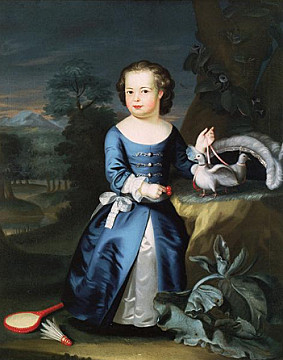Thomas Aston Coffin (1754-1810)
Inspector-General of Public Accounts at Quebec & Commissary-General of England
His portrait (above) was painted by John Singleton Copley in 1758. He was born at Boston and studied at Harvard. Remaining loyal to the Crown, after the War of Independence he became secretary to Guy Carleton (Lord Dorchester), Commander-in-Chief of the British Army in North America. Through the friendship he cultivated in London with Sir Brooks Watson (Lord Mayor of London) he was appointed Inspector-General of Public Accounts and a Justice of the Peace at Quebec.
In Quebec, he amassed a sizeable fortune that he invested in property and in 1796 built himself, "a handsome well built stone house" on Rue Saint-Louis (see images), perhaps the first in Quebec to be built in the fashionable English (as opposed to French) Palladian style (nb. Caldwell Manor and Bowen House). In 1807, he was recalled to London and replaced by John Hale. He auctioned off his library of 600-valuable books, "a quantity of handsome china, plated (vases)... valuable household furniture... Brussels carpets... about 20 superb paintings and prints... several setts of elegant chintz window curtains” etc.
Back in London, he was appointed Commissary-General of England and lived at 27 Abingdon Street in Westminster where he died in 1810. He never married, but he had one daughter (Sarah) by a Sarah Johnston; two more daughters (Marie-Louise and Louisa) by a Louise Benin; and an illegitimate son and heir, Robert Harris Coffin (b.1791) who in 1808 matriculated at University College, Oxford, and inherited from his father just over £10,000 and the house (including its contents and the family portraits) on Abingdon Street. He is buried with a plaque (see images) in St. Margaret's Church next to Westminster Abbey. Thomas was not - as is popularly alluded to - created a Baronet. It was his nephew, Admiral Sir Isaac Coffin, who was created a Baronet in 1804.
In Quebec, he amassed a sizeable fortune that he invested in property and in 1796 built himself, "a handsome well built stone house" on Rue Saint-Louis (see images), perhaps the first in Quebec to be built in the fashionable English (as opposed to French) Palladian style (nb. Caldwell Manor and Bowen House). In 1807, he was recalled to London and replaced by John Hale. He auctioned off his library of 600-valuable books, "a quantity of handsome china, plated (vases)... valuable household furniture... Brussels carpets... about 20 superb paintings and prints... several setts of elegant chintz window curtains” etc.
Back in London, he was appointed Commissary-General of England and lived at 27 Abingdon Street in Westminster where he died in 1810. He never married, but he had one daughter (Sarah) by a Sarah Johnston; two more daughters (Marie-Louise and Louisa) by a Louise Benin; and an illegitimate son and heir, Robert Harris Coffin (b.1791) who in 1808 matriculated at University College, Oxford, and inherited from his father just over £10,000 and the house (including its contents and the family portraits) on Abingdon Street. He is buried with a plaque (see images) in St. Margaret's Church next to Westminster Abbey. Thomas was not - as is popularly alluded to - created a Baronet. It was his nephew, Admiral Sir Isaac Coffin, who was created a Baronet in 1804.
Categories
Share
Image in the Public Domain


